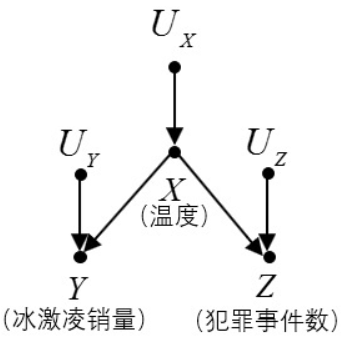干预
此词条暂由因果科学读书会词条梳理志愿者我是猫(74989)翻译审校,未经专家审核,带来阅读不便,请见谅。
来源
干预是因果关系之梯的第二层级,在因果之梯第一层,即便是“以某个变量为条件(conditioning on)”的操作,也只是依据现有观测到的数据进行统计,并没有改变数据的分布。
在实际应用中,干预也非常重要。比如,当我们对一种新的抗癌药物进行研究时,我们试图确定当我们对病人进行药物干预时,病人的病情如何变化。当我们研究暴力电视节目和儿童的攻击行为之间的关系时,我们希望知道,干预减少儿童接触暴力电视节目是否会减少他们的攻击性。
干预(intervention)和以变量为条件(conditioning on)有着本质的区别。当我们在模型中对一个变量进行干预时,我们将固定这个变量的值。其他变量的值也随之改变。当我们以一个变量为条件时,我们什么也不会改变;我们只是将关注的范围缩小到样本的子集,选取其中我们感兴趣的变量的值。因此,以变量为条件改变的是我们看世界的角度,而干预则改变了世界本身。
当我们进行干预以确定一个变量的值时,我们就限制了该变量随其他自然变量而变化的自然趋势。在图模型中,干预的操作将删除所有指向该变量的边。
查询
Queries
Queries are questions asked based on a specific model. They are generally answered via performing experiments (interventions). Interventions take the form of fixing the value of one variable in a model and observing the result. Mathematically, such queries take the form (from the example)
![]() where the do operator indicates that the experiment explicitly modified the price of toothpaste. Graphically, this blocks any causal factors that would otherwise affect that variable. Diagramatically, this erases all causal arrows pointing at the experimental variable.
where the do operator indicates that the experiment explicitly modified the price of toothpaste. Graphically, this blocks any causal factors that would otherwise affect that variable. Diagramatically, this erases all causal arrows pointing at the experimental variable.
More complex queries are possible, in which the do operator is applied (the value is fixed) to multiple variables.
【终译】
查询是基于特定模型提出的问题。他们通常通过进行实验(干预)来回答。干预措施的形式是固定一个模型中一个变量的值,并观察结果。在数学上,这样的查询采取的形式(来自示例)
实验操作者指出实验明确地调整了牙膏的价格。从图形上看,这阻止了任何原本会影响该变量的因果因素。从图表上看,这清除了所有指向实验变量的因果箭头。
可以进行更复杂的查询,其中将 do 运算符(值是固定的)应用于多个变量。
Do算子
Do calculus
The do calculus is the set of manipulations that are available to transform one expression into another, with the general goal of transforming expressions that contain the do operator into expressions that do not. Expressions that do not include the do operator can be estimated from observational data alone, without the need for an experimental intervention, which might be expensive, lengthy or even unethical (e.g., asking subjects to take up smoking). The set of rules is complete (it can be used to derive every true statement in this system). An algorithm can determine whether, for a given model, a solution is computable in polynomial time.
【终译】
Do 演算是一组可用于将一个表达式转换为另一个表达式的操作,其总体目标是将包含 do 操作符的表达式转换为不包含 do 操作符的表达式。不包括 do 操作者的表情可以单独从观察数据中估计出来,不需要实验干预,这可能是昂贵的,冗长的,甚至是不道德的(例如,要求受试者吸烟)。规则集是完整的(可以用它来派生该系统中的每个真实语句)。算法可以确定,对于给定的模型,一个解是否在多项式时间内可计算。
规则
Rules
The calculus includes three rules for the transformation of conditional probability expressions involving the do operator.
【终译】
这个表达式包含了三个涉及 do 运算符的条件概率表达式转换规则。
Rule 1
Rule 1 permits the addition or deletion of observations.:
in the case that the variable set Z blocks all paths from W to Y and all arrows leading into X have been deleted.
【终译】
规则1 允许对观察变量进行增加或者删除
在这个例子中,变量集合Z阻断了所有从W到Y的路径,并且所有指向X的箭头被删除
Rule 2
Rule 2 permits the replacement of an intervention with an observation or vice versa.:![]()
in the case that Z satisfies the back-door criterion.
【终译】
规则2允许用观察来替代干预,或者反之亦然
在这个例子中,变量集合Z满足后门标准
Rule 3
Rule 3 permits the deletion or addition of interventions.:
in the case where no causal paths connect X and Y.
【终译】
规则3允许对干预进行增加或者删除
在这个例子中,X和Y之间没有因果路径相连接
拓展
The rules do not imply that any query can have its do operators removed. In those cases, it may be possible to substitute a variable that is subject to manipulation (e.g., diet) in place of one that is not (e.g., blood cholesterol), which can then be transformed to remove the do. Example:
【终译】
这些规则并不意味着可以删除任何查询的 do 运算符。在这些情况下,可以用一个受操纵的变量(例如饮食)来代替一个不受操纵的变量(例如血液胆固醇) ,然后这个变量可以被转化去除胆固醇。例子:
实例
以图1为例,如果我们要进行干预以降低冰激凌销量(比如,关闭所有冰激凌店),那么我们就去掉所有指向冰激凌销量 的边,并得到如图2所示的图模型。当我们在这个新的图模型中检验相关性时,我们发现犯罪率当然是与冰激凌销量完全独立的,因为冰激凌销量已经与天气温度无关了。换句话说,即使我们将 的值调整为另一个不变的值,这种变化也不会传递给可变的犯罪率 。我们看到,与以某个变量为条件不同,干预一个变量会导致一种完全不同的相关性关系,以某个变量为条件可以完全从数据中获得,但干预却会影响图模型结构的变化。
在符号的表达上,我们使用do算子来表达这种干预。比如,当我们固定Y的值为y时,我们用do(Y=y)来表示这种干预行为。所以P(Z=z|Y=y)表示当以Y=y为条件时Z=z的概率,而P(Z=z|do(Y=y))表示当我们干预Y的值使其为y时,Z=z的概率。从概率分布的角度来说, 表示的是在Y可取的所有值中, Y=y那部分样本对应的Z=z的概率,而P(Z=z|do(Y=y)) 表示的是将每一个样本的Y的值全部固定为y后Z=z的概率。这两者是完全不同的,干预改变了原始数据的分布,而以变量为条件不改变原始数据的分布。

